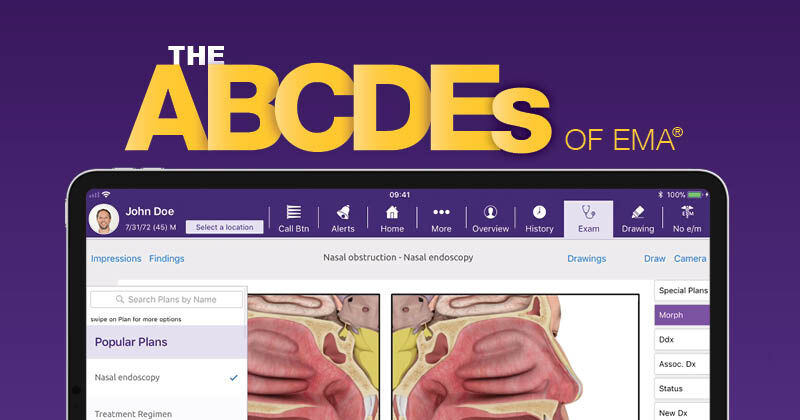The ABCDEs of ENT EHRs

Know the basics of what makes a winning ENT EHR solution for your practice.
Choosing the right ENT software for your busy otolaryngology practice can seem a bit daunting. There are so many options and different vendors that offer various levels of service and product solutions. It’s helpful to have a quick guide that can steer you in the right direction, outlining the must-have items for your practice’s EHR. Being well-versed in EHR terminology can help you, especially if you remember your ABCDE’s. Here are our top five features to consider when selecting your ENT-specific EHR system.
A: Adaptive Learning Engine and Predictive Algorithms
You can’t practice your ABC’s without the letter A. “A” stands for adaptive, and it is a very important feature to keep in mind when considering the best ENT software for your practice. Adaptive learning engines in EHR software allow predictions within specific ENT preferences. Just as when you type something into the Google search bar, and a list of widely searched phrases appear as options—adaptive learning functionality works the same way. As your ENT EHR continues to learn from you by the way you practice, it helps save you time – especially screen time. By streamlining your workflow with regard to specific treatment settings and diagnoses, the adaptive learning engine continues to learn from you.
As you spend less time typing on your screen or keyboard, you can spend more time face-to-face with your patients.
B: Built-In ENT-Specific Content, Ready to Go.
Knowledge of the end-user experience can be critical when it comes to operating your EHR system. So when practicing otolaryngologists build in specific ENT content, it shows. Subspecialties, such as audiology, also benefit from a system that is built by ENT physicians. Every specialty has their own ways of doing things and selecting a reputable EHR vendor that uses real doctors to build out specialty-specific content should be a deciding factor for your practice.
C: Convenient – Saving Time by Using an ENT EHR With Lab Interfaces
Caring for your patients is at the heart of what you do, and so many factors affect the level at which you do this. For instance, when you need to send out labs, it is highly inconvenient when results don’t auto-populate in your electronic chart, or when interfaces aren’t available with practice-wide paths. Fortunately, smarter EHR systems are available as options in the EHR market. Lab connectivity can eliminate wasted time spent filling out forms, scanning reports or faxing multiple lab reports. When you have an intuitive lab interface within your EHR, it can help improve the patient care experience tremendously.
D: Data-Driven Technology
Otolaryngology is an exciting field of research and technology. With different endocrine surgeries and growing subspecialties, having an EHR that collects powerful data is key. With so much new information coming out in the field of ENT, using ENT software that is equipped with capturing actionable data makes both entry and reporting easier.
When it comes to reporting for MIPS, data technology available at your fingertips makes a huge difference. Your ENT software solution should capture this data, cutting down on the time it takes to re-enter information. Using ENT software that gathers information at the point of care puts your practice in a much better position to practice value-based medicine.
E: E-Prescribing – This Includes Electronic Prior Authorization
What could be better than having the ability to prescribe medications right from your EHR? Being able to do it from your cell phone, laptop or iPad. E-prescribing is the last of our top five things to consider when choosing your ENT EHR, and for good reason. As long as you have a cloud-based EHR and an internet connection, the ability to treat your patients and go over prescription medications with them can be much easier. Even a general overview of pricing and comparable pricing options for generic prescriptions may be available.
When it comes to Electronic Prior Authorization (ePA), prescription processing times and payer-specific portals can be eliminated. This can greatly impact the amount of time you spend per patient, as well as help positively affect the patient-doctor experience.
Now You Know Your ABCDE’s – Other Things to Consider
It’s important to be well-versed in the basics of ENT-specific software for your practice. Remember to look for adaptive learning functionality, built-in ENT-specific content, convenient interfaces when it comes to labs, data-driven technology to help you make informed decisions, and ePrescribing that is versatile enough to access from your mobile phone, iPad or desktop.
It’s also very important to find a true, all-in-one system. This means you not only have the clinical side of an EHR, but also dynamic practice management, robust analytics and award-winning customer service* to help show you how to use a smarter, all-in-one EHR system.
When you have an EHR that adapts to your workflow preferences and learns from you, and can assist you with making your practice more efficient and patient-centered, you can truly understand what it means to modernize otolaryngology.